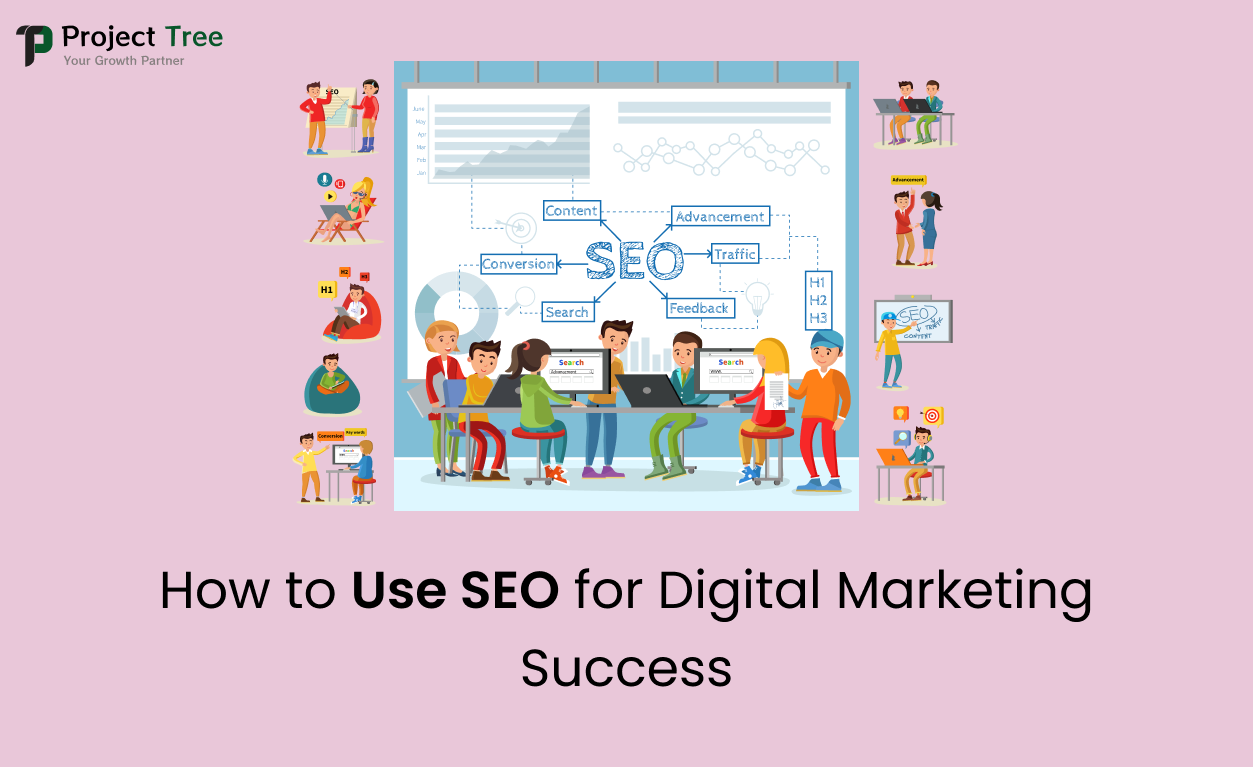Businesses need to put in effective tactics in order to draw in customers and improve their exposure in the highly competitive online marketplace of nowadays. Among the most successful approaches is search engine optimization (SEO). SEO is essential for the success of any kind of digital advertising approach because it improves the website’s contact in search engine results, drives organic traffic, and builds a trustworthy reputation. this deep the piece, we will look into how to use SEO successfully for digital marketing success, focusing on the essential elements and strategies that can yield concrete outcomes.
Introduction to SEO in Digital Marketing
The practice of enhancing your website to rank higher on search engines like Google is known as SEO. The more highly your web page ranks, the more likely it that potential clients will find it when they look for comparable products or services. SEO is far more than simply stuffed keywords and link development; it is about maximizing the overall visitor experience, including the quality of content, site speed, optimization for mobile devices, and much.
SEO must be an essential part of any digital marketing service’s strategy for achievement. An effective SEO strategy may significantly enhance your brand’s online presence, leading to continuous organic traffic and interaction with customers. Let’s get started look at the ways you might employ SEO to enhance your digital marketing efforts.
1. Keyword Research: The Foundation of SEO
Evaluating your keywords is the initial step towards developing a good SEO plan. This includes finding the key regards that your target audience uses to find goods, services, or data about your brand. Tools like as Google Keyword Planner, Ahrefs and and SEMrush may help you find relevant keywords with a high search volume and low complexity.
The written content of your website may then be optimized around the key phrases that you identified. Consider that user purpose ought to constantly guide the keyword choice. If you provide a digital marketing service, terms like “best digital marketing agency,” “digital marketing strategy,” or “online marketing services” can prove useful.
2. On-Page SEO: Optimizing Your Website’s Content
If the On-page SEO is the method of improving each website’s pages to boost their ranking and generate more appropriate arrivals. It includes a variety of strategies, such as:
Optimizing Meta Tags:
Must need to Check that your title tags, meta descriptions, and headers have been optimized with relevant keywords. The title tags must be brief, describing, and include your main keyword.
Creating High-Quality Content:
Content which are instructive, important, and provides consumers true value receives attention by search engines. Plan to develop important which solves inquiries, resolves issues, or educates the audience something. Use keywords organically in your text without overstuffing them, because search engines at times criticize over-optimization.
Internal Linking:
Internal links help search engines to understand the layout of the website and its written structure. Connecting to related places keeps viewers on your site more a longer time, reducing rate of bounce while improving user experience.
Image Optimization:
When appropriate, include terms into the caption that explains the images. To boost website loading efficiency, picture file size ought to be optimized as well.
3. Technical SEO: Ensuring a Solid Website Infrastructure
Technical SEO focuses on the internal structure of your website, providing it simple for search engines to index and crawl your web pages. The key components of technical SEO are as follows:
Website Speed:
Page speed is regarded as a ranking factor. Speedy sites provide an improved user experience, that may help in reducing rates of bounces and boost rankings. Use Google PageSpeed Insights to identify places for improvements.
Mobile Optimization:
A mobile-friendly website is essential, considering that mobile phones and tablets comprise an enormous amount of internet traffic. Google’s mobile-first indexing means that your website’s mobile version is now an important rank factor.
Secure Website (HTTPS):
Check your website have an SSL certificate for safeguarding data because Google prefers secure websites. This not just increases ranks but it also builds trust amongst those you want to attract.
Sitemap and Robots.txt:
The sitemap help the search engines effectively index your pages, while a robots.txt file informs search engines which web pages to crawl and which ones to ignore.
4. Off-Page SEO: Building Authority and Credibility

Off-page SEO relates to attempts which occur outside of your website yet still help with your optimize your website for better SEO approach. The objective is to boost your website’s authority, that plays a significant role in the rankings of search engines.
Backlink Building:
The backlink generation from value websites suggest to search engines that your site is reliable and reputable. The larger number of quality backlinks that possess, the greater your chances of ranking higher. If the Backlinks may be earned by guest blogging, partnerships, influencer marketing, and the creation of popular material like infographics or academic papers.
Social Media Engagement:
While social signals have no direct effect on SEO rankings, maintaining a solid presence on social media may boost traffic to your site and could directly raise your ranks. Share your work across multiple social media networks to increase its visibility.
Local SEO:
Local SEO is essential if your company works in a specific area. Ensure that your company is listed on Google My Business as well as that your NAP, or name, address, and phone data, is accurate across the web. Urge clients to leave positive feedback, as those may improve your local rankings.
5. Content Marketing: Integrating SEO with Valuable Content
SEO and content marketing support one another. With excellent material, the search engine optimization campaign would fail. Important advertising involves offering important, important, and regular substance that encourages and attracts your target audience.
A company that provides digital marketing services, such as Projecttree, can produce blog records, case studies, papers, and flicks that offer information about current marketing developments or concepts to improve digital strategy. Through integrating SEO best practices into this material, such as optimizing on important phrases, offering attractive meta tags, and creating sharing formats, Projecttree could boost business while improving its general search rankings.
6. User Experience and SEO: A Unified Approach
The concepts of user experience (UX) and SEO are inseparable. Internet search engines praise sites that provide an exceptional user experience, so make your site’s usability a major issue. It involves:
Clear Navigation:
Check visitors are able to locate what they’re searching for. An organized site with logical groups and a clear call to action reduces dissatisfaction and bounce rates.
Responsive Design:
Your website should be adaptable to various sizes of screens, providing a perfect viewing experience on desktops, laptops, tablets, and smartphones.
Engaging Content:
To keep users active, use multimedia elements such as movies, images, and infographics. Ensure that your information is easy to read, utilizing short paragraphs, headings, and clear subheadings.
7. Measuring Success: SEO Analytics and Continuous Optimization
If continuous improvement and tracking are necessary for SEO, that cannot be a one-time effort. Using Google Analytics and Google Search Console to track important metrics such as traffic from organic searches, bounce rates, and revenues. These insights will help you determine what is working as well as what needs to be improved.
Keep your content new and pertinent by changing it on a regular schedule, and keep up current on the latest search engine algorithm modifications to keep your site optimised.
8. Voice Search Optimization: The Growing Importance of Voice SEO
The emergence of speech-activated helpers such as Google Assistant, Alexa, and Siri has rendered voice search an essential part of SEO strategies. People favor asking requests in an informal manner when using commands via voice; consequently, optimizing for voice searches takes a somewhat distinct approach from typical SEO. This is how to modify your strategy:
Use long-tail keywords:
Voice search queries are often longer and more conversational. For example, instead of typing “best digital marketing service,” a user might ask, “What is the best digital marketing service near me?”
Target question-based keywords:
Developing content that reacts to specific questions can boost your website’s voice search rank since a lot of search queries take the form of inquiries. Having a FAQ area on the website is a great way to naturally incorporate these types of inquiries.
Featured Snippets:
Information from identified snippets (Google’s top spot) can frequently be obtained via voice search. Organizing your content to respond to frequently asked questions concisely and clearly enhances your chances of being included as a portion, which can be highly beneficial for optimizing for voice searches.
Conclusion
When used effectively, SEO is a powerful tool that may drive digital marketing success. With keyword research to on-page and technical optimization, each aspect of SEO improves your website’s contact and overall performance. With incorporating SEO into your entire digital marketing strategy, you could boost your online presence, attract additional customers, and eventually grow your business. If you’re just beginning or want to enhance your current efforts, continuing to concentrate on SEO will ensure long-term success in the highly competitive field of digital marketing.
ProjectTree and DrPro’s partnership brings a new level of synergy, combining advanced project management tools with innovative healthcare solutions.
FAQs
Q1. What is SEO, and why is it important for digital marketing?
SEO (Search Engine Optimization) is the practice or strategies aimed at improving the exposure of a website within the search engine listing. Reasons why it is important for digital marketing are because it enables organic traffic within your site, hence boosting leads and conversions.
Q2. How do keywords impact SEO?
Keywords are the words actual users enter into search engines. By directing your content at specific keywords, you are more likely to see your content appear in search options, and this can help potential customers find your digital marketing service.
Q3. How long does it take to see SEO results?
As a discipline, SEO is very much a marathon, and this means that it often takes at least 3 to 6 months before one can easily begin to see some marked improvements in the page rankings and the organic traffic.
Q4. What role does mobile optimization play in SEO?
Mobile optimization takes care of the view of a site on handheld devices such as phones and tablets. In light of this, any action that goes against Google’s mobile-first indexing is likely to cost rankings or, at best, fail to give you an improvement.
Q5. Can social media activity help with SEO?
Social media doesn’t have a direct impact on SEO, but it can positively complement and influence better search engine performance through traffic generation, backlink generation, and brand awareness.

